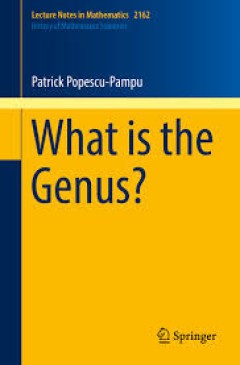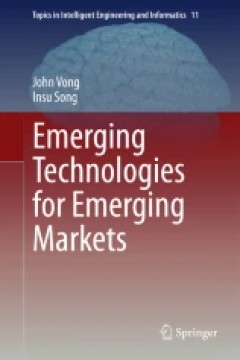Filter by

Scientific Inquiry in Mathematics - Theory and Practice
This valuable resource provides an overview of recent research and strategies in developing and applying modelling to promote practice-based research in STEM education. In doing so, it bridges barriers across academic disciplines by suggesting activities that promote integration of qualitative science concepts with the tools of mathematics and engineering. The volume’s three parts offer a com…
- Edition
- 1
- ISBN/ISSN
- 978-3-319-89524-6
- Collation
- Mathematics
- Series Title
- -
- Call Number
- 510

What is the Genus?
Exploring several of the evolutionary branches of the mathematical notion of genus, this book traces the idea from its prehistory in problems of integration, through algebraic curves and their associated Riemann surfaces, into algebraic surfaces, and finally into higher dimensions. Its importance in analysis, algebraic geometry, number theory and topology is emphasized through many theorems. Al…
- Edition
- -
- ISBN/ISSN
- 978-3-319-42312-8
- Collation
- -
- Series Title
- -
- Call Number
- -

Emerging Technologies for Emerging Markets
This book introduces inclusive-cost-effective (ICE) approaches that have the potential to transform all aspects of daily lives of people at the base of the pyramid in the economic scale, who represent more than 75% of the world population. ICE means that the approaches must meet the affordability level at the base of the pyramid. This includes mobile banking and financial service technologies, …
- Edition
- -
- ISBN/ISSN
- 978-981-287-347-7
- Collation
- 49 b/w illustrations
- Series Title
- -
- Call Number
- --

Cultures of prediction :how engineering and science evolve with mathematical …
"This book provides a longue dur?ee story examining the dynamic history of predictive methods and values in sciences--and particularly in engineering and other applied sciences--which is crucial to understanding today's culture of prediction"--OCLC-licensed vendor bibliographic record.
- Edition
- -
- ISBN/ISSN
- 9780262379045
- Collation
- 1 online resource.
- Series Title
- -
- Call Number
- -

Sharing our science :how to write and speak STEM
"This book is a personal, practical, and inspirational guide for scientists and other technically trained professionals who seek to be more effective and empathetic in their writings for professional and nontechnical audiences"--OCLC-licensed vendor bibliographic record.
- Edition
- -
- ISBN/ISSN
- 9780262376402
- Collation
- 1 online resource
- Series Title
- -
- Call Number
- -

Mathematical tools for real-world applications :a gentle introduction for stu…
"This book teaches various analysis, research, and problem-solving methods in an easy-to-follow, practical manner"--OCLC-licensed vendor bibliographic record.
- Edition
- -
- ISBN/ISSN
- 0262370328
- Collation
- 1 online resource (1 volume)
- Series Title
- -
- Call Number
- -

The math you need :a comprehensive survey of undergraduate mathematics
A comprehensive survey of undergraduate mathematics, compressing four years of study into one robust overview. In The Math You Need, Thomas Mack provides a singular, comprehensive survey of undergraduate mathematics, compressing four years of math curricula into one volume. Without sacrificing rigor, this book provides a go-to resource for the essentials that any academic or professional needs.…
- Edition
- -
- ISBN/ISSN
- 9780262375757
- Collation
- 1 online resource (488 pages).
- Series Title
- -
- Call Number
- -

Leibniz on binary :the invention of computer arithmetic
"Among his extraordinary mathematical and philosophical achievements, Gottfried Wilhelm Leibniz (1646-1716) invented binary arithmetic, the representational basis for today's world of digital computing and communications. This book will be the first to make a selection of his writings available in English. Strickland and Lewis provide an accessible introduction to Leibniz through some twenty mo…
- Edition
- -
- ISBN/ISSN
- 0262372134
- Collation
- 1 online resource.
- Series Title
- -
- Call Number
- -

The raven's hat :fallen pictures, rising sequences, and other mathematical ga…
"Introducing complex math concepts through the medium of seemingly unsolvable games"--OCLC-licensed vendor bibliographic record.
- Edition
- -
- ISBN/ISSN
- 0262363623
- Collation
- 1 online resource.
- Series Title
- -
- Call Number
- -

The constitution of algorithms :ground-truthing, programming, formulating
"Ethnographic study of the constitution of algorithms"--OCLC-licensed vendor bibliographic record.
- Edition
- -
- ISBN/ISSN
- 9780262363235
- Collation
- 1 online resource.
- Series Title
- -
- Call Number
- -
 Computer Science, Information & General Works
Computer Science, Information & General Works  Philosophy & Psychology
Philosophy & Psychology  Religion
Religion  Social Sciences
Social Sciences  Language
Language  Pure Science
Pure Science  Applied Sciences
Applied Sciences  Art & Recreation
Art & Recreation  Literature
Literature  History & Geography
History & Geography